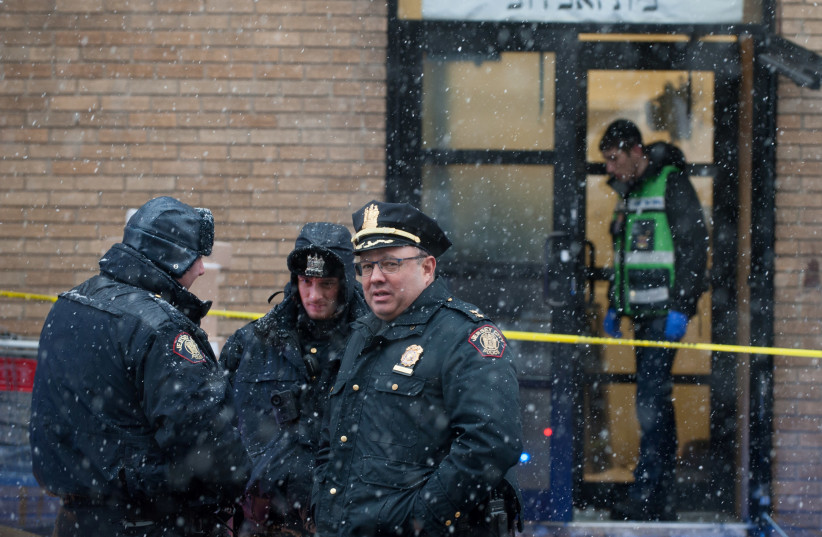 A history of the Black Hebrew Israelites
A history of the Black Hebrew Israelites
ILANIT CHERNICK
Jersey City shooter 47-year-old David Anderson was found to have ties to the movement

(photo credit: REUTERS/LLOYD MITCHELL)
Fuelled by anti-Jewish and anti-law enforcement sentiments, 47-year-old David Anderson and 50-year-old Francine Graham murdered a police officer and three members of the Jersey City Jewish community during a targeted shooting attack on Tuesday night.
During a news conference on Thursday,New Jersey Attorney General Gurbir S. Grewa confirmed this, “We believe the suspects held views that reflected hatred of the Jewish people, as well as the hatred of law enforcement.”
According to The New York Times, Anderson allegedly had ties to the Black Hebrew Israelite movement, although the strength of these ties is still unclear.
The Black Hebrew Israelites have a long and interesting history in the United States, but it needs to be made clear that today there are numerous streams of the movement and it is only a small fraction that have extreme views.
According to Jacob Dorman, an associate professor at the Department of History and Core Humanities Program at The University of Nevada in Reno, the movement was born in the 1890s “and its first wave came out of the Holiness movement,” which he explained was mainly based on the Frontier.
Dorman told The Jerusalem Post that these groups ”’reverse engineered’ Judaism from the Hebrew Bible, following a strain of biblical literalism found in the spirit-filled Holiness church.”
He made it clear that they focused on the Old Testament and its biblical literalism like certain dietary laws and customs, but it doesn’t include the Talmud.
“The also had a deep fascination with the Exodus narrative in African-American religion, freemasonry, and the Anglo-Israelite movement,” he continued. “It was initially an interracial movement and one of the most influential bishops [at the time] was white, but it became a majority black movement.
He said that the second wave of the movement came out of the Harlem Renaissance during the 1920s and the Great Migration, which began in 1916.
“The second wave was deeply influenced by Rabbi Arnold Josiah Ford, who was actually from Barbados… his congregation was based in Harlem for decades,” Droman explained. “He helped to train rabbis including Rabbi Wentworth Arthur Matthews,” who was originally from the West Indies.
Matthews built up a strong community in New York and “also reached out to leaders of the second generation to help train the third generation.”
He believed that African-Americans were of the original Jews, descended from the Lost Tribes. He also trained and ordained rabbis, some of which moved to Chicago.
The second wave was deeply influenced by the pan-African philosophy of Marcus Garvey of Jamaica, who was founder of the Universal Negro Improvement Association.
They initially referred to themselves as Black Jews, but it was during the third wave of the movement, which emerged in the 1960s and 1970s that “they rejected the label Jew and preferred Israelite,” Dorman said.
“They also created a form of religion that’s not based on imitating Ashkenazi Judaism but emphasizes the primacy of Black Israelite and it happens during the Black Power movement so there’s a lot of nationalism and emphasis on self-determination and black beauty standards independent of white standards, veganism, and the doctrine that black people have been lied to for centuries about who they are and their true origins and their religious destiny, which is quite central to it.”
He made it clear that “only a small fraction” can be extremist or have anti-Jewish views.
“There are probably far more Black Jews and Black Israelites who are not antisemitic, hostile or violent,” Dorman concluded.
In Israel, there is also a break-off from the movement known as the African Hebrew Israelites of Jerusalem, who today live in the southern city of Dimona. However, despite being initially influenced by the original movement, Matthews and later Rabbi Reuben of the Chicago Congregation of Ethiopian Hebrews, in 1966, 27-year-old Ben Ammi Ben-Israel had a vision in which the angel Gabriel appeared to him, telling to take his people to Israel.
According to Prince Immanuel Ben Yehuda, who sits on the Dimona community’s council, in 1967, Ben-Israel first moved to Liberia with 350 community members from the America’s for two and a half years “to shed the many negative attributes” from life in the city before “we could return to the Holy Land.
But in 1969, only 110 of Ben-Israel’s followers made it to Israel, while 240 had returned to America during their time in Liberia.
He stressed that there are a lot of differences between the African Hebrew Israelites of Jerusalem and the Hebrew Israelites in the US, which includes lifestyle and traditions.
“Our young people serve in the IDF and we love the State of Israel and its people,” Ben Yehuda told the Post. “Our young people have been raised to defend this country and its people.”
Ben Yehuda added that their youth also represents Israel in international forums that include academics and athletics.
Asked about his thoughts on the Jersey City shooting, he expressed his deep condolences to the Jewish community following the attack and called on people not to paint the entire African Hebrew Israelite community with one brush.
“Just as there are many different streams of Judaism, there are many streams of the African Hebrew Israelite movement,” he stressed. “It was very painful to witness this – our hearts and prayers are with them.”
“We are living in dangerous times around the world,” he added, emphasizing that a change in world leadership is desperately needed to stop “fanning the flames of hatred and division that we are seeing today.
“We need new visions and voices for peace,” Ben Yehuda concluded.
Zawartość publikowanych artykułów i materiałów nie reprezentuje poglądów ani opinii Reunion’68,
ani też webmastera Blogu Reunion’68, chyba ze jest to wyraźnie zaznaczone.
Twoje uwagi, linki, własne artykuły lub wiadomości prześlij na adres:
webmaster@reunion68.com
